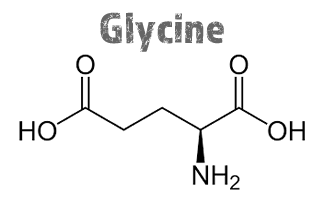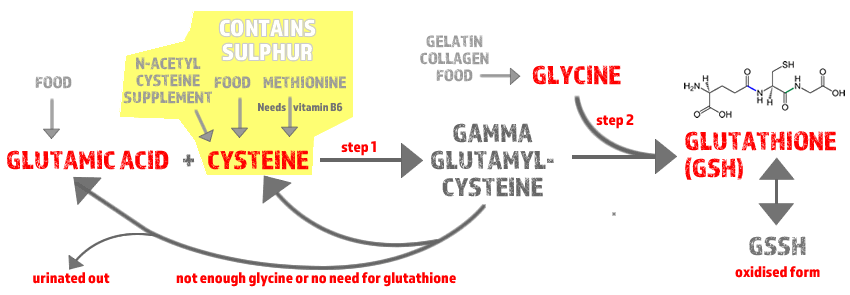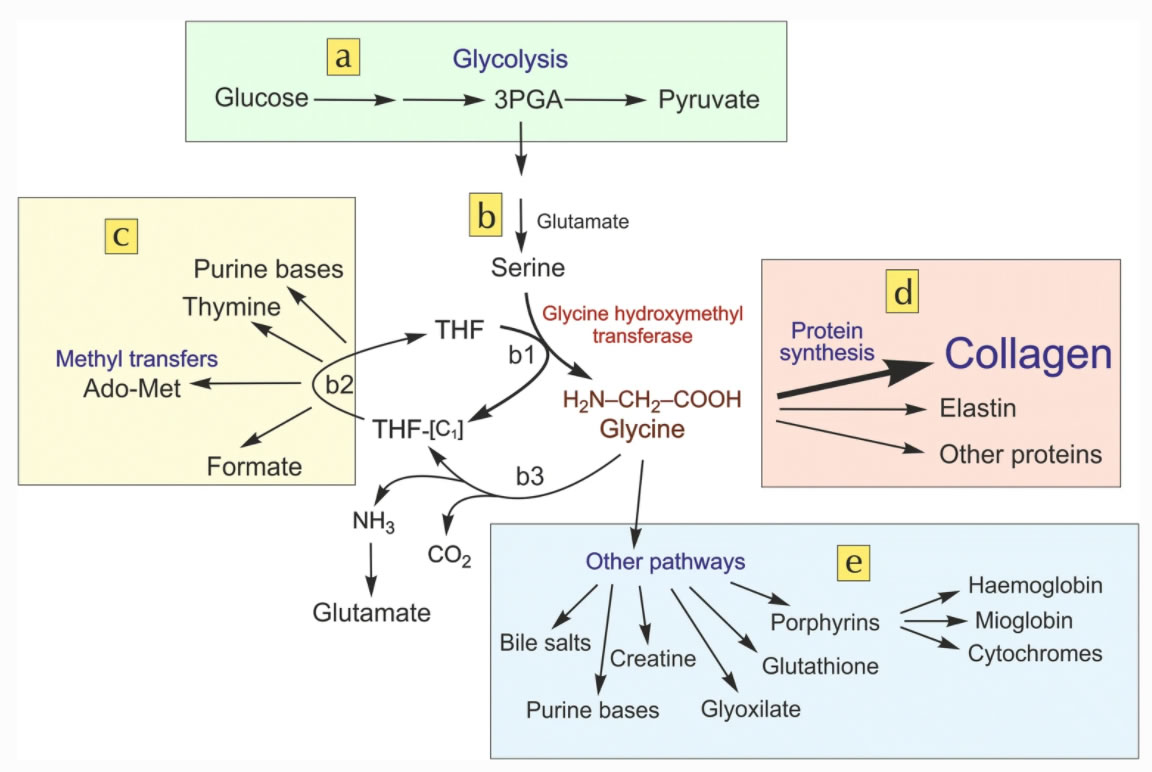Glycine Nutrition Advice
Amino acids are the building blocks that form proteins. Our body needs 20 different amino acids to maintain health. 11 are made by our bodies (these are called non-essential) and 9 are derived from our diet (these are called essential).
You can think of amino acids as Lego bricks that come in many different shapes and sizes. When you consume protein-rich food, it is broken down to form amino acids. The body then combines these organic lego bricks to make new material such as muscle and hormones. The smallest amino acid is glycine, and it offers a vast range of health benefits, it's a multifunctional powerhouse which plays a pivotal role in nutrition and metabolism. Here are some of the key features of glycine:
- Can be taken as a cheap supplement.
- It comes as an inexpensive bulk powder which tastes sweet, so you can even add a teaspoon to your daytime coffee!
- Assists with testosterone production.
- Component of creatine.
- Essential for many muscle, cognitive and metabolic functions.
- Found in high concentrations in the skin, connective tissues and bones.
- A major inhibitory neurotransmitter in the brainstem and spinal cord.
- Important for the construction of healthy DNA and RNA strands.
- Glycine is a popular supplement to aid sleep quality.
- Glycine is also a component of glutathione, which is a critical cellular anti-oxidant.
- Glycine has been used in the fight against Covid-19.
- Glycine taken with NAC (n-Acetyl Cysteine) is proven to aid longevity. GlyNAC
- Anti-inflammatory and protective roles in cases of acute pancreatitis, gastric ulcers, and arthritis.
- Helps with ulcers, leaky gut syndrome, diabetes, kidney and heart failure, brain disorders, fatigue, sleep disorders and certain cancers.
- Glycine is found in high-protein foods, most notably in meat, fish, eggs, dairy and legumes.
- A daily diet typically includes about 2 grams of glycine.


Glycine and Glutathione
Glutathione (GSH) is a short chain of 3 amino acids, every cell in our body produces glutathione Glutathione is synthesised in the body from the amino acids L-cysteine, L-glutamic acid and glycine, and we can get it from foods.
- Every cell in our body produces glutathione and it's the most important antioxidant.
- Glutathione is a valuable antioxidant that’s used to prevent cellular damage and reduce signs of ageing. It scavenges free radicals throughout the body and recharges other antioxidants, thus preventing chronic diseases.
- Glutathione is central to recovery from exercise, it makes you feel good and prevents or overcomes both infectious diseases and chronic degenerative diseases.
- Glutathione protects your vision, boosts your immune system, helps turn carbohydrates into energy and prevents the buildup of oxidised fats that may contribute to heart disease.
- Glutathione protects cellular components from free radicals, peroxides, lipid (fat) peroxides, and heavy metals.
- Glutathione can dramatically raise energy levels, strengthens your immune system, fights inflammation, improves athletic performance, detoxifies the body, aids in cellular repair and slows down the ageing process.
- Glutathione blocks NF-κ, the master controller of inflammation in the body. This protein complex increases the activity of various inflammatory genes and their products
- A healthy adult has about 10g of glutathione circulating within the body tissues.
- Don't take a glutathione supplement, focus on consuming the building blocks. Taking glutathione by mouth does not appear to be an effective way to get it into your body. It is thought that glutathione may be broken down by enzymes in the stomach. The FDA has not approved glutathione supplements for any medical purpose.

Muscle Growth and Glycine
- Glycine helps to stop the breakdown of proteins that form and repairs muscle
- Glycine maintains muscle mass into old age and prevents loss of cartilage in joints
- Glycine is used during the biosynthesis of creatine, which provides muscles instant fuel. Creatine synthesis requires three amino acids: glycine, methionine and arginine, plus three essential enzymes
Bones, Joints, Skin and Glycine
Collagen is a type of protein found mainly in bones, tendons, ligaments, skin and other connective tissue. Collagen consists of amino acids wound together to form a triple-helix. One-third of collagen is composed of glycine, and it promotes joint, tendon and ligament health.
As you get older, it’s important to consume enough amino acid building blocks in order to repair damaged tissues within joints. Our skin is made from collagen (your skin will regenerate itself approximately every 21 days, that's almost 4 kilograms of skin cells every year!).
Glycine and Covid-19
Glycine reduces tissue damage and cytokine storms in COVID-19 patients (study | study). Glycine has demonstrated both cellular-protective and anti-inflammatory properties in patients. Dietary intake of glycine significantly reduced liver and lung tissue damage. Results have been very promising, especially in obese cases, a very relevant finding since obesity has been linked with increased COVID-19 hospitalizations. In human cystic fibrosis patients, oral glycine (at 0.5g/kg daily) reduced inflammatory cytokines, tumor necrosis factor, and improved clinical status.
Glycine cannot prevent a Covid-19 infection, but glycine is a fantastic supplement that will improve your general health and help mitigate the damaging effects that a Covid-19 infection can cause.
Glycine, the Brain and Sleep
- Glycine acts as brain neurotransmitter in a similar way to GABA. It is in fact released with GABA to calm parts of the central nervous system. Glycine supplements improve sleep quality, lessen daytime sleepiness, and improve the performance of memory recognition tasks. A recent study showed glycine triggered a drop in body temperature and at the same time helped people fall asleep more quickly and spend more time in REM sleep and help you move more quickly into a deep, slow-wave sleep.
- Glycine modulates excitatory neurotransmissions as well, helping with sleep, memory, mental performance, stress, anxiety and even mental illness.
- Glycine can also regulate nerve impulses throughout the body by balancing electrolyte levels, such as calcium, chloride and potassium.
- Glycine may reduce hyperactivity in the brain and play a role in the treatment or prevention of mental disorders, such as learning disabilities, schizophrenia, bipolar disorder, depression and epilepsy.
- Glycine is often used in the treatment of schizophrenia, typically alongside other medications, to help reduce symptoms. Glycine is also given to patients who’ve suffered a stroke, as a treatment to help limit damage to the brain within the first six hours of the stroke.
- Glycine is required by the body for the maintenance of the central nervous system and studies have shown that glycine can be beneficial in cases of multiple sclerosis, and its inhibitory action can help to prevent epileptic seizures
- Glycine has also been used in treating manic psychological states and has a calming effect on the brain (Study).
Glycine and Blood Sugar Stabilisation - Diabetes
Glycine helps with blood sugar problems. Research shows that 3-5 grams of glycine supplement taken before each meal leads to a significant increase in blood sugar stabilisation. This amount of glycine would be difficult to get consuming either bone broth or collagen.
Glycine and B Vitamin Status
Glycine buffers excess methyl groups in the body. Methylation is a biochemical process that impacts on B vitamin status, and without adequate B vitamins, the body generates less glycine. Low vitamin B6 can lead to a multitude of health issues.
Glycine, Cellular Health and Ageing
Cells depleted of glutathione are susceptible to damage. Low levels of glutathione trigger a cascade that ultimately leads to cell damage and cell death, which accelerates ageing. Glycine is a critical amino acid during fetal growth and is necessary for both the synthesis and methylation of DNA during fetal growth. Throughout our lifetimes, glycine continues to play an important role in cellular health.
Glycine and Cancer
Glycine has anti-cancer properties. Research shows that glycine inhibits cancer cell proliferation in liver and skin cancer patients. Kupffer cells in the liver help protect against certain pathogens and toxins, however they produce oxidants which damage liver cells and cause cancer. Glycine is reported to block oxygen production by Kuppfer cells. Glycine also blocks blood vessel formation in skin cancer tumours, reducing their size.
However, research shows that glycine has a different effect on other forms of cancers, so reducing glycine intake could be an effective treatment for some cancer patients.
Glycine and Gut Health
Digestive disorders and autoimmune conditions have reached epidemic proportions, so it’s worth ensuring you are getting enough glycine to help promote gut health.
Glycine is involved in digestion, specifically in the breakdown of fatty acids in foods. It also helps maintain healthy levels of acidity in the digestive tract. Glycine helps form the gut lining and helps rebuild tissue that lines the digestive tract, keeping food particles and bacteria inside the gut where they belong.
Collagen and gelatin help people with food allergies and sensitivities tolerate foods that would normally cause a bad reaction. They can soothe the lining of the GI tract in people with inflammatory bowel diseases and indigestion problems. There is a lot of positive research linking glycine's beneficial effects on leaky gut syndrome, IBS, Crohn’s, ulcers and acid reflux). Glycine even promotes microbiome balance and growth.
By restoring gut health you also support your immune system.
Glycine + NAC (GlyNAC) for longevity
In a 2022 study, the researchers found that supplementing Glycine and N-Acetylcysteine in older adults Improves glutathione deficiency, oxidative stress, mitochondrial dysfunction, inflammation, physical function, and aging markers. The key here is the improvement in glutathione because of the use of 2 out of the 3 building blocks. GlyNAC is an effective nutritional supplement that improves and reverses multiple age-associated abnormalities to promote health.
Glycine Supplements
It's pretty easy to find a food-grade or pharmaceutical-grade bulk glycine supplement (1kg in powder form). It looks like sugar and is sweet. Don't buy glycine tablets or capsules as they typically only contain 500-1000mg of glycine, and so it's pretty insignificant.
- 1 kilo of glycine typically costs under £5 (UK Bulk Powders)
- Glycine is also available on Amazon, eBay and Lazada

A teaspoon full of glycine powder weighs around 4g and you can take it by adding to water or juices. Glycine tastes great because it's sweet, the name glycine is derived from the Greek word Glykys for 'sweet'. In the daytime, you can use glycine as a sugar alternative in coffee.
Some other super supplements to take alongside glycine would include:
- Raw whey protein (undenatured) which provides the key amino acids cysteine, glycine and glutamate)
- N-Acetyl Cysteine (NAC) which is a component of glutathione AND is very liver protective, especially for drinkers
- Vitamin C which is central to collagen production
- A good B vitamin complex
- L-Arginine which is a great inexpensive amino acid
High glycine concentrations increases collagen synthesis. Acute glycine deficiency could be an important cause of osteoarthritis.

a) Glycolysis reactions.
b) Pathway of serine and glycine synthesis.
c) Processes involved in metabolism to different products including methyl transfers.
d) Processes of protein biosynthesis involving glycine, especially the synthesis of collagen.
e) Set of pathways that use glycine as a metabolite for other biosynthetic processes.
Glycine intake strategy
Glycine can be taken in supplement form, but it’s also plentiful from natural food sources. Pure food grade gelatin or hydrated collagen can be supplemented. The best food source of glycine is bone broth (boiling up bones, but it's quite variable). Most people already get around 2g of glycine daily from their diets, but needs differ a lot depending on someone’s level of activity and state of health. Daily doses of up to 50g are safe. Our recommendation for a healthy dose would be 5g before your first meal (glycine blunts the blood sugar response) and 3g before bed (glycine is great for winding down to a deep sleep).
Adequate intake: 2-3g daily
Theraputic dose: 20g+.
Upper tolerable limit: There is no upper limit of glycine at this time
In an article from Pubmed, detailed assessment of all possible sources of glycine shows that synthesis from serine accounts for more than 85% of the total, and that the amount of glycine available from synthesis, about 3 g/day, together with that available from the diet, in the range 1.5-3.0 g/day, may fall significantly short of the amount needed for all metabolic uses, including collagen synthesis by about 10 g per day for a 70 kg human. This result supports earlier suggestions in the literature that glycine is a semi-essential amino acid and that it should be taken as a nutritional supplement to guarantee a healthy metabolism.
80% of the total glycine in the body is used for protein synthesis, and without it, we would die. Of the total amino acid content in the human body, glycine makes up 11.5%. We require around 2 grams of glycine which is either manufactured by the body or obtained from food each day.
Glycine references
https://freenutrition.co.uk/nutrients/glycine
https://www.mdpi.com/2072-6643/11/6/1356/htm
https://www.ncbi.nlm.nih.gov/pmc/articles/PMC3921923
https://link.springer.com/article/10.1007/s00726-018-2611-x/figures/1
https://www.ncbi.nlm.nih.gov/pmc/articles/PMC5855430
https://openheart.bmj.com/content/1/1/e000103
https://diabetes.diabetesjournals.org/content/65/8/2311
https://pubmed.ncbi.nlm.nih.gov/29094215/
https://www.ncbi.nlm.nih.gov/pmc/articles/PMC7574884/
https://www.ncbi.nlm.nih.gov/pmc/articles/PMC6627940
https://www.longdom.org/abstract/d-llysine-acetylsalicylate-glycine-impairs-coronavirus-replication-15312.html
https://www.cochranelibrary.com/central/doi/10.1002/central/CN-02133847/full
https://pubmed.ncbi.nlm.nih.gov/22732655/
https://journals.physiology.org/doi/full/10.1152/ajpregu.00159.2004
https://pubmed.ncbi.nlm.nih.gov/12450897
https://pubmed.ncbi.nlm.nih.gov/21795440
https://pubmed.ncbi.nlm.nih.gov/7376793
https://pubmed.ncbi.nlm.nih.gov/20093739
https://pubmed.ncbi.nlm.nih.gov/11456285

